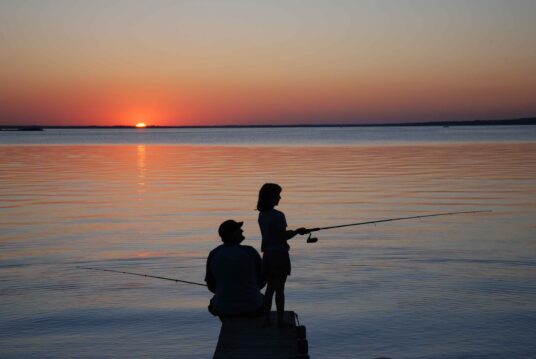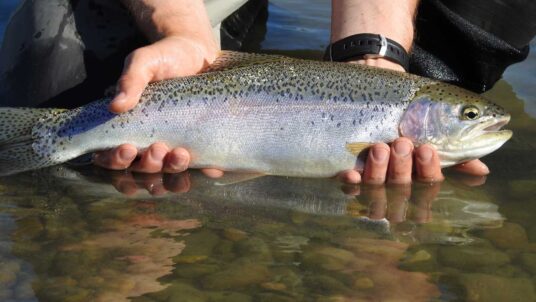Fishing Alberta’s Capital Region

One of the best-kept secrets of living in the greater Edmonton area is the diversity of fishing opportunities right out our back door. The North Saskatchewan River slides lazily through the heart of the city, there are numerous stocked ponds in and around Edmonton, as well as several lakes offering excellent fishing just a short drive away. If you’re new to fishing, it can be a daunting task—understanding where and how to begin can be overwhelming if you don’t have a mentor to help you along. Fortunately, the road to fishing success, even for first-timers, is paved with a plethora of online resources to help you and your family land the first of many wriggling fish in no time.
–
Licensing and Regulations
Fishing in Alberta is governed by annual regulations that define when and where you can to fish, what methods you’re allowed to use, and how many fish you can keep. Be aware that these regulations vary between waterbodies and species of fish, so always “check the regs” for the river, lake or pond you plan to fish.
First off, you’ll need to get your license, unless you’re under the age of 16 or over 65, then you’re off the hook so to speak. If you’re a first-time license holder, you’ll also need a WIN (Wildlife Identification Number). Licenses and WINs can be purchased at most outdoor retailers, or you can buy them online.
To view the fishing regulations, or to purchase your WIN and fishing licence, go to albertarelm.com

–
Learning to Fish
If you’re new to fishing, a great way to start is by taking two informative fishing education programs offered by Alberta Hunter Education Instructors’ Association (AHEIA). The first, the Alberta Fishing Education Program, consists of eight modules that take you through step-by-step key aspects of learning to fish—including an overview of Alberta’s fisheries management, fish identification, basic equipment and techniques, cleaning and cooking your catch, understanding safety considerations, and more. Best of all, it’s absolutely free! Check it out at Alberta Fishing Education Program | AHEIA
Learning to identify the species of fish you’re catching is important, particularly since regulations about how many you can keep differ between species. Fortunately, AHEIA’s online Identification of Alberta’s Game Fish Quiz will teach you what to look for in identifying your fish, and the common mistakes made in differentiating between species. This free course is available at Identification of Alberta’s Game Fish Quiz | AHEIA

Sunsetting behind fishing rods and people fishing off the dock at Pigeon Lake. 
Rainbow Trout caught during surveys
–
Basic Equipment and Techniques
One of the best things about fishing is that it’s easy—getting started requires minimal equipment that’s both affordable and simple to use. While fishing retailers can be imposing places for newcomers, with their endless shelves of rods, reels, lures and other fishing gear, you’ll find that the staff welcoming and ready to help you find the tackle you need.
To get started, and depending upon where you plan to fish, you’ll need a basic spinning reel and rod combination, fishing line, a leader, some split-shot weight to get your bait down into the water column, a bobber or two, and a small selection of hooks and lures. Some rod/reel combinations even come with a basic selection of tackle that’s enough to get you started catching fish. Expect to pay less than $50 in total to get outfitted.
Practice casting and retrieving in a nearby open field before you hit the water. Tie on a small weight instead of hook when doing this—it’s much safer this way!
You’ll also find lots of information online to help you on your journey. One of the very best and most comprehensive sites is ab-conservation.com/go-fish/learn-to-fish/
Depending on where and what you’ll be fishing for, your setup and how you use it will vary. Following are some tips to get you started.
–
Stocked Ponds
Ponds stocked with rainbow trout are easy to fish and a great choice for novice anglers. A common setup requires that you tie a single hook directly to the end of your line. Bait your hook with either a piece of worm or a leech. Note: There are bait restrictions on some bodies of water, so be sure to check the regulations before you head out. Crimp on a couple small split-shot weights about 24 inches above the hook, and attach a bobber a couple feet above that. Cast your bait out, then let it sit, watching the bobber for any sign a fish has taken the bait. If the bobber is moving, or disappears under the water, give your line a slight tug to set the hook, and then reel in your prize. If you’re not having any luck, adjust the height of the bobber to present the bait either shallower or deeper. You don’t need to cast out far on stocked ponds, as most fish will be found no more than 30 feet from shore.
–
Lakes
Pike, walleye and perch are the common fish species in most of the lakes in the greater Edmonton area that are not stocked with trout. They can be caught on a variety of tackle, including lures that you cast and retrieve, or bait, where legal, presented under a bobber or affixed to a jig, then cast out and slowly retrieved. When casting baited jigs, make sure your jig is heavy enough that it’s bouncing along the bottom as you reel it in—that’s where the fish are most likely to be. When fishing with lures, such as spoons or spinners, retrieve them just quickly enough that you can feel them wobbling as they’re pulled through the water. Tie a wire leader to your line whenever fishing pike waters as these toothy fish may bite through your line and take your lure with them!
–
Rivers
The challenge when fishing rivers, especially the North Saskatchewan River in Edmonton and area, is the current. If you fish with bait, you’ll need to use enough weight that your bait sits relatively stationary on the bottom. With enough weight, baited jigs and “pickerel rigs” are sure to attract fish. Our river is home to a wide variety of fish species, from relatively small goldeye to gargantuan lake sturgeon— you never know what’s on the end of the line when you feel that first tug. Casting spoons, spinners and other hard-bodied lures is also effective, but generally not as productive in the river as fishing with bait.

Sunsetting behind fishing rods and people fishing off the dock at Pigeon Lake. 
Todd Zimmerling took his daughter and her friend out for fishing.
–
Where to Go
Living in the greater capital region means you have access to a wide range of fishing-friendly waters. For beginning anglers, stocked trout ponds provide an easy, safe and rewarding way to dip your toe into the angler’s world. Alberta Environment and Parks (AEP) and the Alberta Conservation Association (ACA) stock a long list of ponds and lakes each year with rainbow trout. Check out ACA Stocked Lakes – ACA (ab-conservation.com) for the full list.
One of the more popular local stocked ponds is the Hermitage Park Pond on the east side of Edmonton. This pond is open to the public and invites family fishing, making it ideal for learning to fish. You can cast from shore or, bring along a canoe, kayak or other non-motorized boat. Each angler is allowed to keep up to five rainbow trout, perfect for a family meal of fresh-caught fish!
There are many other family-friendly stocked ponds in the region, with favourites including Beaumont Pond, Gibbons Park Pond and Muir Lake.
The North Saskatchewan River is home to a wide diversity of fish species, and on a good day you can easily catch three, four or five different types of fish! Popular fishing spots along the river include Dawson Park, Hermitage Park, Strathcona Science Park, Gold Bar Park and Whitemud Park—although virtually any place you can get access to the riverbank will produce fish. Creek mouths, storm water discharges, bridge pilings, riprap shorelines, back eddies, foam lines and natural deep holes all offer prime holding and feeding habitat for fish. When all else fails, select deeper water over shallower water, remembering that outside bends in the river are typically faster and deeper than inside turns.
Note: The North Saskatchewan River is deep and moves more swiftly than it appears to. For safety reasons, children should not be permitted to fish along the river unless accompanied by an adult and should wear personal flotation devices, even when fishing from shore.
For those interested in fishing one of the capital region’s many lakes, popular destinations include Wabamun Lake, Lac Ste. Anne, Pigeon Lake, and Gull Lake. Those are but a few, but there are many other lakes that offer wonderful fishing opportunities, both from shore or from a boat. Be sure to check the regulations as to how many fish you are permitted to keep.
Fishing offers hours and hours of fun for kids and the whole family! There’s no better time to learn than now.

Produced and sponsored by Alberta Conservation Association.
More Like This
Ultralight
Read
Wagner Natural Area
Read
FireFly Theatre
Read











